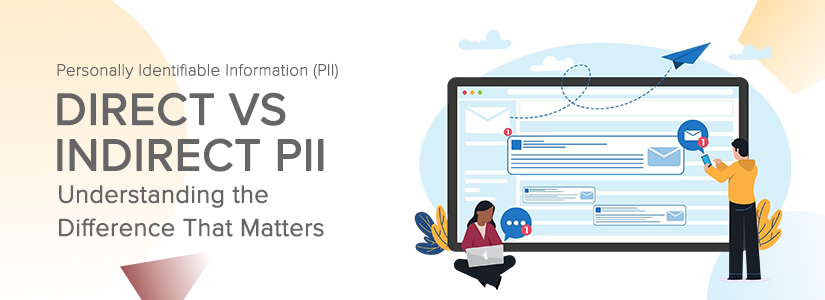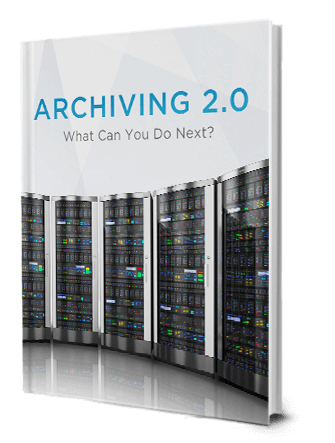Direct vs Indirect PII: Understanding the Difference That Matters

Introduction
When it comes to safeguarding data, the type of personal information you collect and how it’s handled can make all the difference.
Organizations are familiar with the term “Personally Identifiable Information” (PII); few understand that there are two key types: direct and indirect PII. Each plays a different role in risk exposure and regulatory compliance, and both demand careful handling.
In this blog, we’ll cover:
- Direct vs. indirect PII, with real examples
- How combining indirect data can expose identities
- Real cases: WhatsApp scam & Twitter leak
- Key privacy laws: GDPR, HIPAA, CCPA
- Best practices: audits, encryption, limit data
A Quick PII Overview
Personally Identifiable Information (PII) is any data that can identify or trace an individual, either directly or when combined with other information. Protecting PII is crucial in today’s digital world to prevent identity theft, fraud, and privacy breaches.
Key points to know:
- PII includes direct identifiers (SSN, legal name, biometric) and indirect identifiers (date of birth, zip code).
- Every day, digital activities generate data that contribute to detailed personal profiles.
- Exposure of PII in data breaches can lead to financial loss or damage to a company’s reputation.
- Adhering to data privacy regulations is critical in ensuring proper protection and personal information management
What Is Direct PII?
What Is Direct PII?
Direct PII (or direct identifiers) are data points that can be used on their own to identify an individual without the need for any additional information. These identifiers are typically unique to a person and are often regulated under strict laws, which include HIPAA, GDPR, and CCPA.
Due to the fact that direct identifiers point to one specific individual, they carry a high risk if exposed or mishandled.
Common Examples of Direct PII:
Organizations that collect or store direct PII are often required to encrypt, mask, or limit access to this data to comply with data privacy regulations and reduce breach risk. Failure to protect direct PII can result in identity theft, financial loss, and legal penalties.
What Is Indirect PII?
Indirect PII (or indirect identifiers) cannot identify a person on their own. Yet, when combined with other data points, they can be used to reveal someone’s identity.
Indirect PII is dangerous precisely because it appears harmless at first. However, when cybercriminals or data analysts gather these data points, they can re-identify individuals with a high degree of accuracy
Common Examples of Indirect PII:
A famous study showed that 87% of Americans could be uniquely identified by just three indirect PII points: zip code, birth date, and gender. Data that appears anonymized can still pose a threat when cross-referenced with other accessible information.
How Personal Data Can Be Combined and Misused
Even with limited information consisting of zip code, age range, and gender (indirect PII identifiers), it’s possible to uncover more than you might expect. While these data points may seem harmless in isolation, data mining tools and publicly accessible databases can be used to significantly narrow down potential matches, particularly in smaller communities or niche industries. When combined with additional public records or online activity, this partial data can quickly create a detailed profile.
Here’s how it works:
- Breach #1: Your job title and work email leak in a LinkedIn-style breach.
- Breach #2: Your birth date and zip code are exposed in a health-related database.
- Social media clues: Your Instagram profile confirms your gender and city.
- Outcome: An attacker can identify you, even if your name was never breached.
This tactic is known as data mosaic.
It enables attackers to use fragments of indirect PII to build a full identity profile. These profiles can then be sold on the dark web, used for phishing attacks, or leveraged in social engineering schemes.
Implications for Compliance
Understanding the difference between direct vs indirect PII isn’t just a technical detail, it’s a legal necessity. Most modern data privacy regulations recognize both types of identifiers, and failure to secure either one can result in fines, lawsuits, or reputational damage.
Notable Data Privacy Laws
- GDPR — Requires protection for any information that can “directly or indirectly” identify a person.
- HIPAA — Treats combinations of indirect PII (like birth dates + locations) as Protected Health Information (PHI).
- CCPA/CPRA — Includes household and behavioral data as identifiers that must be disclosed and protected.
Each regulation mandates different levels of accountability, yet they share a common principle: protecting any data that can identify someone, whether directly or indirectly, is essential.
Real-World Case Study:
Twitter Data Leak (2020)
In 2020, a security vulnerability in Twitter’s platform exposed the phone numbers and email addresses linked to millions of user accounts. While the leak did not include passwords or other crucial identifiers, the exposed contact information was enough for attackers to target users with sophisticated phishing campaigns and identity scams.
WhatsApp Business Account Scam (2023)
In 2023, scammers exploited WhatsApp Business accounts by collecting publicly visible data—like phone numbers (direct identifier) and profile details (indirect identifier)—to impersonate legitimate businesses.
By combining this data with social engineering tactics, attackers convinced customers to share sensitive details or make unauthorized payments. As a result, over 330,000 reports of business impersonation scams and 160,000 involving government impersonators have occurred in 2023.
Bottom Line:
These real-world cases show how both direct and indirect personal data, whether exposed through platform vulnerabilities or publicly visible profiles, can be pieced together to enable targeted scams and identity fraud.
These incidents highlight the urgent need to protect all forms of Personally Identifiable Information (PII), not just the sensitive ones. Proactively safeguarding PII is essential to reducing risk, building trust, and staying resilient in an increasingly data-driven world.
Direct vs Indirect PII: Key Differences at a Glance
| Aspect | Direct PII | Indirect PII |
| Identification | Identifies an individual on its own | Requires a combination with other data |
| Risk level | High (identity theft, fraud) | Moderate to high (risk depends on context) |
| Examples | Name, SSN, passport number | Zip code, gender, job title |
| Protection Required | Encryption, redaction, and strict access controls | Data aggregation limits, anonymization |
| Regulatory focus | Regulated by most laws | Increasingly regulated due to re-ID risk |
Best Practices to Handle Direct and Indirect PII
Organizations must understand that protecting PII goes beyond securing names and social security numbers.
Here are practical steps to safeguard both types:
- Conduct data audits — Identify where direct and indirect PII lives in your systems.
- Apply access controls — Limit who can access sensitive data based on role.
- Encrypt data at rest and in transit — This applies to direct identifiers, especially, but anonymization of indirect identifiers is also important.
- Use data minimization — Don’t collect more information than you need.
- Regularly update privacy policies — Ensure they reflect the risks of indirect PII.
Summary: Key Takeaways on Direct vs. Indirect PII
- Two forms of PII: Direct (SSN, full name) and Indirect (zip code, job title).
- Indirect PII is just as important, especially when combined with other data, as it can expose identities.
- Real-world cases, including the Twitter data leak and WhatsApp scam, show how even small data points can be misused.
- Direct PII may grab headlines, but as data becomes more interconnected, the line between direct and indirect is blurring.
- Data mosaic techniques allow attackers to combine scattered data and re-identify individuals.
- Privacy Laws (GDPR, HIPAA, and CCPA) require the protection of both types of PII.
- Organizations that stay proactive with encryption, audits, and data minimization are better protected and more compliant.
- Treat all personal data with care, not just the sensitive pieces.
Frequently Asked Questions (FAQ)
How can businesses effectively balance data collection for personalization while respecting privacy?
Businesses should implement data minimization—collect only what is necessary—and be transparent about data use. Using anonymization and pseudonymization techniques can help personalize services without exposing direct identifiers. Regular privacy impact assessments and obtaining clear user consent also strengthen trust.
What emerging technologies pose new challenges for PII protection?
Technologies such as AI and machine learning can infer sensitive information from everyday data that seems harmless, increasing re-identification risks. IoT devices continuously collect personal data, often without clear user awareness.
How does cross-border data transfer affect PII protection compliance?
Different countries have varying privacy laws. Transferring PII across borders requires compliance with regulations like GDPR’s strict data export rules or adequacy decisions. Companies must use standard contractual clauses, binding corporate rules, or ensure equivalent protections to avoid legal penalties.
How do data breaches involving PII impact customer trust long-term?
Breaches can severely damage trust, leading to customer churn and reputational harm. Transparent communication and swift remedial actions post-breach are critical to rebuilding confidence. Investing in robust data protection measures upfront can prevent breaches and demonstrate commitment to privacy.



